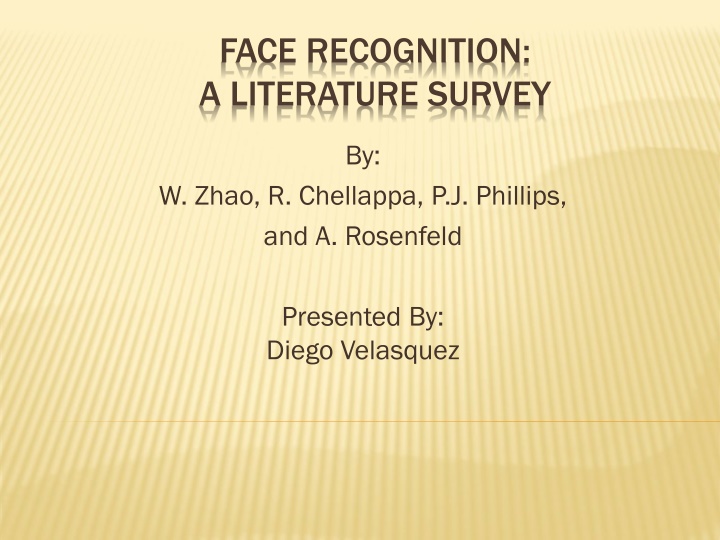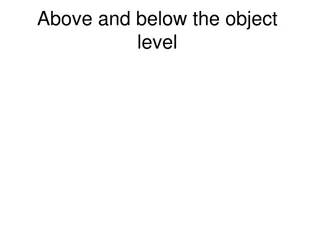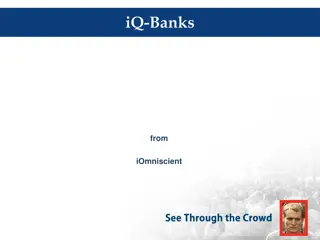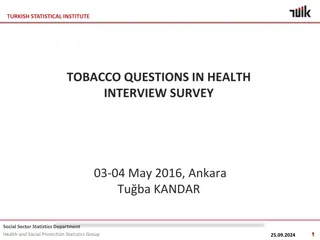Face Recognition: A Comprehensive Literature Survey
This literature survey delves into the importance and challenges of face recognition technology, covering topics such as biometrics, human face recognition, variations in pose and illumination, early and modern approaches, as well as the evaluation of face recognition systems. The need for face recognition is highlighted in various applications including criminal identification, video surveillance, security systems, and entertainment. The study also discusses the challenges faced in face recognition due to variations in lighting and pose. It compares early techniques, which relied on 2D pattern recognition, with modern appearance-based models tested on large databases. Overall, the survey sheds light on the advancements and complexities of face recognition technology.
Download Presentation

Please find below an Image/Link to download the presentation.
The content on the website is provided AS IS for your information and personal use only. It may not be sold, licensed, or shared on other websites without obtaining consent from the author.If you encounter any issues during the download, it is possible that the publisher has removed the file from their server.
You are allowed to download the files provided on this website for personal or commercial use, subject to the condition that they are used lawfully. All files are the property of their respective owners.
The content on the website is provided AS IS for your information and personal use only. It may not be sold, licensed, or shared on other websites without obtaining consent from the author.
E N D
Presentation Transcript
FACE RECOGNITION: A LITERATURE SURVEY By: W. Zhao, R. Chellappa, P.J. Phillips, and A. Rosenfeld Presented By: Diego Velasquez
CONTENTS Introduction Why do we need face recognition? Biometrics Face Recognition by Humans Challenge in Face Recognition Variation in pose Variation in illumination Early Work/Modern Work Aspects of face recognition Approaches use for recognition EIGENFACE TECHNOLOGY PDBNN Video-based Face Recognition Evaluation of face recognition systems Face Recognition Grand Challenge
WHY DO WE NEED IT? Easy way to discover criminals Video Surveillance Portal Control Investigations Smart Cards Devices log-on ATM cards Entertainment Video Games Human-robot/computer-interaction
BIOMETRICS Consists of methods for uniquely recognizing humans based upon one or more intrinsic physical or behavioral traits. In computer science, in particular, biometrics is used as a form of identity access management and access control. It is also used to identify individuals in groups surveillance. that are under
FACE RECOGNITION BY HUMANS Relevant studies in psychophysics and neuroscience that will help with the design of face recognition systems: People remember faces more easy than other objects. People focus in odd features (eg. Hears). People rank facial features.
CHALLENGE IN FACE RECOGNITION Illumination variation Images of the same face look different because the change of the light. Pose Variation Same face in different angles could give a different output.
EARLY WORK Use techniques base on 2D pattern recognition. Use measured attributes of features (distance- measuring algorithms). These determined the distances between important features like eyes and compared these distances to the distances on known faces in the database. Performance is poor with variations of the same face and size, is not accurate. Does well with variations in intensity.
MODERN WORK Appearance-based model, heavily tested with large databases, with positive outcomes. Feature-based models has been successful as well, and more accurate in the two challenges( light and pose variation) Techniques for feature extraction are not adequate, for example, it won t detect if an eye is close or not.
ASPECTS OF FACE RECOGNITION, CONTINUED Face detection: Locating the faces in an image or video sequence. Feature extraction: Finding the location of eyes, nose, mouth, etc. Face recognition: Identifying the face(s) in the input image or video. Identification/Verification: The system needs to confirm or reject the claimed identity of the input face.
FACE DETECTION First step of any system. Two statistics are important: positives (also referred to as detection rate) and false positives (reported detections in non-face regions). Multiview-based methods for face detection are better than invariant feature methods when is used for head rotations. Appearance-based methods have achieved the best results in face detection, compared to feature-based and template-matching methods.
FEATURE EXTRACTION Three types of approaches: Generic methods based on edges, lines, and curves. Feature-template-based methods that are used to detect facial features such as eyes. Structural matching consideration geometric constraints on features. Is the most important step for face recognition, even the most complete methods need to know the exact location of the feature for normalization. First methods use emphasized in some features. methods that take into template model that
EIGENFACE The first successful method for facial recognition. Take an input image and then projecting into a new dimension called facespace .
EIGENFACE CONTINUED To identify a face, the algorithms do: Registration: Transformed the input image to facespace , then is saved in a new representation. Eigenpresentation: Every face in the database is encoded into a representation call template. principal component analysis (PCA) is used to encode face images and capture face features. Identification: this last step is done by comparing the input image with the ones in the database using the templates, and then selecting the best match
NEURAL NETWORK What is it? Is a mathematical model or computational model that is inspired by the structure and/or functional aspects of biological neural networks. NN technology gives computer systems an amazing capacity to actually learn from input data. It s easy to train a neural network with samples which contain faces, but it is much harder to train a neural network with samples which do not, and the number of non-faces is too large.
NN ON FACE RECOGNITION It has a filter at the beginning of the process that scan the whole image, and take each portion to see if the face exist in each window. Merging all this pieces after the filter help the NN to eliminate false detections. NN has a high level of accuracy when the images has lighting conditions.
PDBNN A fully automatic face detection recognition system based on a neural network. A proposed fully automatic face detection and recognition system based on Probabilistic Decision-Based Neural Networks has been proposed. It consists of three modules: A face detector, eye localizer, and face recognizer. The PDBNN uses only the up side of the face; the reason to not use the mouth is to avoid the expressions that cause motion around the mouth.
PDBNN CONTINUED Advantages of this implementation are that it converges quickly and is easily implemented on distributed computing platforms. Has a lower false acceptance/rejection rate because it uses the full density description for each class. The system could have problems when the number of classes grows exponentially.
Main Feature: Each class is designed to recognize one person
VIDEO-BASED FACE RECOGNITION Three Challenge: The quality of video is low. Usually, video acquisition occurs outdoors (or indoors but with bad conditions for video capture). Face image are small: Make the recognition task more difficult, because affect the accuracy of face segmentation, as well as the accurate detection of the crucial points/landmarks that are often needed in recognition methods. The characteristics of faces/human body parts: It is easier to localized a face, but not recognize an specific one.
BASIC STEPS OF VIDEO-BASED FACE RECOGNITION Face Segmentation and Pose Estimation: For segmentation motion and/or color information is used and locations of feature points can be used for pose estimation. Multiview face with different angles can be used to do pose and segmentation at the same time. Face and feature tracking: The goal of this step is to analyzed the 3D depth of points of the image sequence. Face Modeling: Using a 3D model to match frontal views of the face.
EVALUATION OF FACE RECOGNITION SYSTEMS Since the topic become so important for society available face databases have been collected and corresponding testing protocols have been designed. The FERET protocol (1994). Free database Consists of 14,126 images of 1199 individuals. Three evaluation tests had been administered in 1994, 1996, and 1997. Sets of 5 to 11 images of each individual were acquired under relatively unconstrained conditions
EVALUATION OF FACE RECOGNITION SYSTEMS CONTINUE The XM2VTS protocol (1999). This protocol was defined for the task of verification Expansion of previous M2VTS program (5 shots of each of 37 subjects). Now consists 295 subjects. The results of M2VTS/XM2VTS can be used in wide range of applications.
FACE RECOGNITION GRAND CHALLENGE FACE RECOGNITION GRAND CHALLENGE FRGC ran from May 2004 to March 2006. The primary goal of the FRGC was to promote and advance face recognition technology designed to support existing face recognition efforts in the U.S. Government. Sponsors: Intelligence Advanced Research Projects Agency (IARPA) Department of Homeland Security (DHS) FBI Criminal Justice Information Services Division Technical Support Working Group (TSWG) National Institute of Justice. The FRGC consisted of progressively difficult challenge problems. The Face Recognition Grand Challenge (FRGC) was designed to achieve this performance researchers a six-experiment challenge problem. goal by presenting to
FACE RECOGNITION GRAND FACE RECOGNITION GRAND CHALLENGE CONT. CHALLENGE CONT. FRGC provide data corpus of 50,000 images. The data consists of 3D scans and high resolution still imagery taken under controlled and uncontrolled conditions.
FRGC RESULTS The results indicated that the new algorithms are 10 times more accurate than the face recognition algorithms of 2002 and 100 times more accurate than those of 1995. Some of the algorithms were able to outperform human participants in recognizing faces and could uniquely identify identical twins.
ETICS ISSUES WITH FACE RECOGNITION The use of facial recognition in public places is unethical ? Who gets to add pictures to the database of wanted faces? Who has access to the database, internally and externally? What recourse do people have if they are entered into the database incorrectly? Should we trust the software?
REFERENCES W. Zhao, R. Chellappa, A. Rosenfeld, and P.J. Phillips, Face Recognition: A Literature Survey. P. Jonathon Phillips, Patrick J. Flynn, Todd Scruggs, Kevin W. Bowyer, William Worek, Preliminary Face Recognition Grand Challenge Results. Wikipedia























